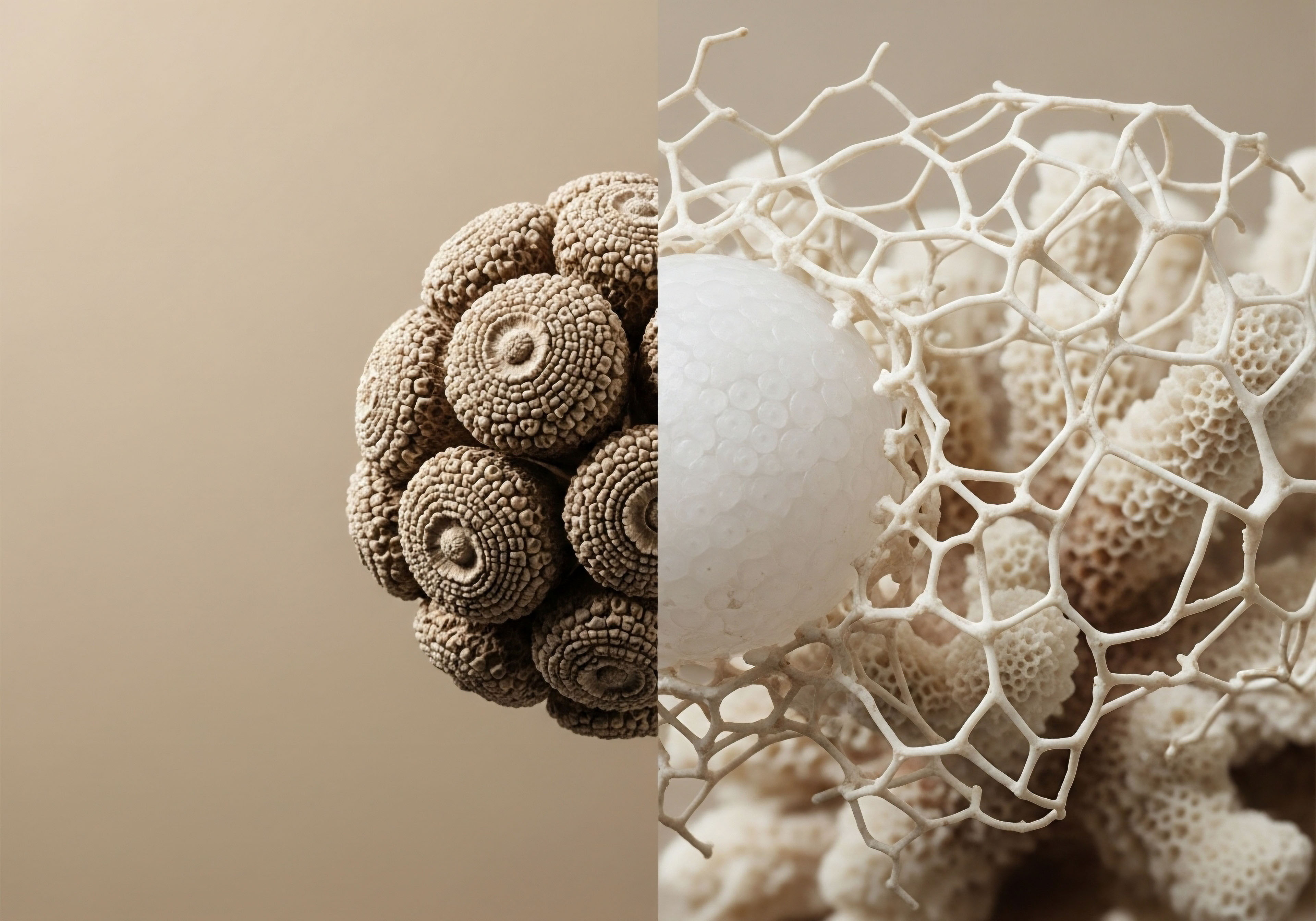

Fundamentals
The conversation about sexual vitality often begins quietly, as a personal and deeply felt observation. It might be a slow fading of desire, a change in performance, or a general sense that the robust energy that once defined you has diminished. These experiences are valid and significant.
They are data points, your body’s method of communicating a profound shift in its internal environment. Understanding this communication is the first step toward reclaiming function and well-being. The capacity for a healthy sexual life is a direct reflection of overall systemic health, an elegant indicator of biological harmony. When vitality wanes, it signals a disruption in the intricate communication network that governs your body’s systems.
At the center of this network is the endocrine system, a collection of glands that produce and secrete hormones. These chemical messengers travel throughout your body, coordinating everything from your metabolism and stress response to your mood and sexual function. The primary sex hormones ∞ testosterone, estrogen, and progesterone ∞ are powerful metabolic regulators that also govern reproduction.
Their balance is essential for optimal function in both men and women. A decline in sexual vitality is frequently linked to a disruption in the production or signaling of these key hormones, a process that can be influenced by age, lifestyle, and underlying health conditions.

The Central Command System
Your body’s hormonal symphony is conducted by a sophisticated control system known as the Hypothalamic-Pituitary-Gonadal (HPG) axis. Think of it as a three-part communication relay. The hypothalamus in the brain sends a signal (Gonadotropin-Releasing Hormone, or GnRH) to the pituitary gland.
The pituitary, in turn, releases its own signaling hormones (Luteinizing Hormone, or LH, and Follicle-Stimulating Hormone, or FSH) into the bloodstream. These hormones travel to the gonads (the testes in men and the ovaries in women), instructing them to produce testosterone and estrogen, as well as to manage fertility through sperm and egg development.
This entire system operates on a feedback loop; when sex hormone levels are adequate, they signal the hypothalamus and pituitary to slow down their signaling, maintaining a state of equilibrium.
A disruption anywhere along this axis can lead to diminished sexual function. The issue may originate in the brain’s signaling or with the gonads’ ability to respond. This is a critical distinction because it informs the entire therapeutic approach. Simply adding more hormones to the system may not address the root cause if the underlying issue is a communication breakdown within the central command system itself.
A decline in sexual vitality is often the body’s primary signal of a broader systemic or metabolic imbalance.

Foundational Strategies a Universal Starting Point
Before considering specific therapeutic agents, it is essential to recognize that the health of the endocrine system is deeply intertwined with metabolic function, stress levels, and nutrition. These foundational elements represent a universal, non-personalized strategy that is beneficial for everyone.
Chronic stress, poor sleep, a diet high in processed foods, and a sedentary lifestyle can all contribute to hormonal dysregulation. For instance, high levels of the stress hormone cortisol can suppress the HPG axis, reducing testosterone production. Similarly, insulin resistance, a hallmark of metabolic syndrome, is strongly associated with erectile dysfunction and low libido in men.
Therefore, the initial approach to restoring vitality involves optimizing these core pillars of health. This includes adopting a nutrient-dense diet, engaging in regular physical activity, prioritizing restorative sleep, and managing stress. For many individuals, these lifestyle modifications can significantly improve hormonal balance and sexual function, potentially reducing or eliminating the need for more advanced interventions.
This foundational work ensures that any subsequent therapeutic strategy is built upon a stable and receptive biological environment. It is the process of clearing the lines of communication so the body’s own signaling can be heard again.


Intermediate
When foundational lifestyle strategies are insufficient to restore optimal function, a more direct approach to hormonal modulation may be warranted. This is where therapeutic interventions, guided by clinical assessment and laboratory testing, come into play. The goal of these protocols is to re-establish physiological balance within the endocrine system.
The decision to initiate such a therapy is based on a comprehensive evaluation that includes a detailed symptom history and blood analysis to quantify hormone levels and other relevant biomarkers. This data provides a clear picture of where the communication breakdown is occurring, allowing for a targeted and effective response.

How Do Clinicians Determine a Starting Protocol?
The development of a therapeutic plan begins with a thorough diagnostic process. Clinicians look beyond a single testosterone reading to assess the entire hormonal cascade. This includes measuring levels of total and free testosterone, estradiol (a potent form of estrogen), LH, FSH, and Sex Hormone-Binding Globulin (SHBG), a protein that binds to testosterone in the blood, making it inactive.
By analyzing the relationships between these markers, a clinician can differentiate between different types of hormonal dysfunction. For example, low testosterone with high LH and FSH suggests a problem at the level of the gonads (primary hypogonadism), while low testosterone with low or normal LH and FSH points to a signaling issue from the pituitary or hypothalamus (secondary hypogonadism). This distinction is critical for selecting the appropriate therapeutic tools.

Standard Protocols for Male Hormone Optimization
For men diagnosed with hypogonadism, the standard of care often involves Testosterone Replacement Therapy (TRT). The objective is to restore testosterone levels to a healthy physiological range, thereby alleviating symptoms like low libido, fatigue, and loss of muscle mass. A common and effective protocol involves weekly injections of a long-acting form of the hormone, such as Testosterone Cypionate. However, a well-designed protocol is more complex than simply administering testosterone.
Exogenous testosterone administration suppresses the HPG axis, shutting down the body’s natural production of LH and FSH. This leads to testicular atrophy and cessation of sperm production. To counteract this, clinicians often include a signaling peptide called Gonadorelin. Gonadorelin is a synthetic version of GnRH, the hormone released by the hypothalamus.
By mimicking this initial signal, it stimulates the pituitary to continue releasing LH and FSH, thereby maintaining testicular size and function. Another critical component is managing the conversion of testosterone to estrogen. An enzyme called aromatase converts a portion of testosterone into estradiol.
On TRT, this can lead to elevated estrogen levels, causing side effects like water retention and gynecomastia (breast tissue development). To manage this, an Anastrozole tablet, which is an aromatase inhibitor, is often prescribed to block this conversion and maintain a healthy testosterone-to-estrogen ratio.
| Component | Mechanism of Action | Primary Purpose |
|---|---|---|
| Testosterone Cypionate | Directly replaces the body’s primary androgen. | Restore serum testosterone to optimal physiological levels. |
| Gonadorelin | Mimics GnRH to stimulate LH and FSH release from the pituitary. | Maintain testicular function and size during TRT. |
| Anastrozole | Inhibits the aromatase enzyme, blocking the conversion of testosterone to estradiol. | Control estrogen levels and prevent related side effects. |
| Enclomiphene/Clomiphene | A Selective Estrogen Receptor Modulator (SERM) that blocks estrogen receptors in the hypothalamus, increasing GnRH release. | Can be used to stimulate the HPG axis, sometimes as an alternative to TRT or for fertility restoration. |

Hormonal Support for Women
Hormonal balance in women is a dynamic process that changes throughout the menstrual cycle and across the lifespan. The transition into perimenopause and menopause is characterized by fluctuating and ultimately declining levels of estrogen and progesterone, leading to symptoms like hot flashes, mood swings, and a decrease in sexual desire.
While estrogen replacement is a well-known therapy, the role of testosterone in female vitality is increasingly recognized. Women produce testosterone in their ovaries and adrenal glands, and it is crucial for libido, energy, and cognitive function.
Therapeutic protocols for women often involve a combination of hormones tailored to their specific needs and menopausal status. This may include bioidentical estrogen and progesterone to manage menopausal symptoms. For concerns related to sexual vitality, a low dose of Testosterone Cypionate can be highly effective.
The dosage is significantly lower than that used for men, administered to restore levels to the upper end of the normal female range. In some cases, long-acting testosterone pellets implanted under the skin are used. As with men, if testosterone is administered, an aromatase inhibitor like Anastrozole may be considered if there are concerns about its conversion to estrogen, although this is less common in female protocols.
A standardized protocol acts as a well-calibrated starting point, which is then refined based on an individual’s symptomatic and biochemical response.

Beyond Hormones the Role of Peptides
In some cases, the issue with sexual vitality is not primarily hormonal but is related to other signaling pathways in the body, particularly those originating in the central nervous system. Peptide therapies represent a newer class of interventions that can target these specific pathways. Peptides are short chains of amino acids that act as highly specific signaling molecules.
- PT-141 (Bremelanotide) ∞ This peptide is unique because it works directly on the brain to increase sexual arousal. It is a melanocortin receptor agonist, activating pathways in the hypothalamus that are involved in sexual motivation. This makes it a valuable tool for individuals, both male and female, whose low libido is not resolved by hormone optimization alone. It addresses the neurological component of desire directly.
- Growth Hormone Peptides ∞ Peptides like Sermorelin or a combination of CJC-1295 and Ipamorelin are used to stimulate the body’s own production of growth hormone from the pituitary gland. While primarily known for their effects on body composition and recovery, growth hormone plays a role in overall vitality and well-being. Improved energy levels and better sleep quality resulting from these therapies can have a significant positive impact on sexual health.
These intermediate strategies, whether hormonal or peptide-based, represent a move from broad support to targeted intervention. They are still based on well-established protocols but are selected and adjusted based on an individual’s unique biological profile. The necessity of further personalization arises when these standard approaches do not yield the desired results or when the underlying biological picture is unusually complex.


Academic
A sophisticated examination of sexual vitality requires moving beyond a simple model of hormone replacement. It necessitates a systems-biology perspective, viewing the body as an interconnected network where hormonal, metabolic, and neurological systems are in constant dialogue. The question of whether personalized strategies are always necessary finds its answer in the complexity of this network.
For individuals with straightforward hormonal deficiencies, standardized protocols are often sufficient. However, for a significant portion of the population, particularly those with comorbidities, restoring vitality requires a deeply personalized approach that addresses the root causes of systemic dysregulation. The most profound of these connections is the interplay between the Hypothalamic-Pituitary-Gonadal (HPG) axis and overall metabolic health.

The Metabolic-Endocrine Interface a Two-Way Street
The HPG axis does not operate in a vacuum. It is exquisitely sensitive to the body’s metabolic state. Conditions such as obesity, insulin resistance, and chronic inflammation create a hostile biochemical environment that directly impairs hormonal signaling. Adipose tissue (body fat) is not inert; it is an active endocrine organ that produces inflammatory cytokines and the enzyme aromatase.
In men, excess adipose tissue leads to increased aromatization of testosterone into estradiol. This elevation in estrogen provides negative feedback to the pituitary gland, suppressing LH output and consequently reducing the testes’ production of testosterone. This creates a vicious cycle where low testosterone promotes fat gain, and increased fat further suppresses testosterone.
Insulin resistance presents another layer of complexity. High levels of circulating insulin can interfere with hormonal signaling in multiple ways. It can decrease levels of SHBG, which, while increasing free testosterone, also disrupts the overall balance and can have other negative metabolic consequences.
In women, high insulin is a key driver of Polycystic Ovary Syndrome (PCOS), a condition characterized by hormonal imbalance and ovulatory dysfunction. From a clinical standpoint, attempting to correct low testosterone without addressing underlying insulin resistance is like trying to fill a leaky bucket.
The therapeutic effect of exogenous hormones will be blunted by the persistent metabolic dysfunction. A truly personalized strategy, therefore, must include interventions aimed at improving insulin sensitivity, such as nutritional ketosis, exercise, and targeted pharmaceuticals like metformin or GLP-1 agonists, alongside any hormonal support.

What Are the Limits of a Purely Hormonal Approach?
Relying solely on hormone administration can mask underlying pathologies and may be insufficient for long-term resolution. For instance, a man with low testosterone secondary to metabolic syndrome might see an initial improvement in libido with TRT. However, if his insulin resistance and inflammation are not addressed, he remains at high risk for cardiovascular disease, diabetes, and other chronic conditions.
The restoration of sexual vitality in this context is incomplete because the systemic health of the individual has not been fully restored. This highlights a limitation of a one-size-fits-all approach and underscores the need for personalization based on a comprehensive health assessment.
Furthermore, the brain’s role in sexual response is paramount. Desire, arousal, and orgasm are complex neurological events. Hormones like testosterone are critical for priming these circuits, but they are not the only factors. Neurotransmitters such as dopamine and serotonin, and signaling molecules like nitric oxide, are also essential.
This is where therapies like PT-141 demonstrate the value of a multi-pronged approach. PT-141 acts on melanocortin receptors in the central nervous system, bypassing the traditional hormonal axis to directly stimulate the pathways of desire. In a patient whose hormonal profile has been optimized but who still experiences low libido, the issue may lie within these neurological circuits.
A personalized plan for this individual might involve combining hormonal support with a centrally-acting agent like PT-141 to address both the physiological and neurological components of their dysfunction.
| Therapeutic Agent | Primary System Targeted | Mechanism of Action | Level of Personalization |
|---|---|---|---|
| Testosterone Cypionate | Endocrine System (HPG Axis) | Exogenous hormone replacement. | Moderate (Dosing adjusted to lab values and symptoms). |
| Metformin / GLP-1 Agonists | Metabolic System | Improves insulin sensitivity and glucose metabolism. | High (Prescribed based on specific metabolic markers). |
| PT-141 (Bremelanotide) | Central Nervous System | Melanocortin receptor agonist, enhances desire pathways. | High (Used for specific cases of low libido unresponsive to hormonal therapy). |
| CJC-1295 / Ipamorelin | Endocrine System (GH Axis) | Stimulates endogenous growth hormone release. | Moderate to High (Used for vitality, recovery, and body composition goals). |

The Future Is Personalized
The evolution of medicine is moving away from broad-stroke treatments and toward precision interventions. The field of endocrinology and sexual health is at the forefront of this shift. While standardized protocols provide a valuable and effective starting point for many, they represent the beginning of the therapeutic journey, not the end.
True optimization requires a dynamic and iterative process of testing, treating, and re-evaluating. It involves layering therapies that address different biological systems ∞ correcting the metabolic environment, balancing the hormonal milieu, and fine-tuning neurological pathways.
Therefore, personalized therapeutic strategies become necessary when an individual’s biology deviates from the standard model. This deviation can be caused by genetic predispositions, lifestyle factors, or the presence of chronic disease. The necessity for personalization is directly proportional to the complexity of the individual’s case.
For the young, healthy individual with simple primary hypogonadism, a standard TRT protocol may be all that is needed. For the middle-aged individual with metabolic syndrome, type 2 diabetes, and low libido, a personalized, multi-system strategy is not just beneficial; it is essential for achieving a complete and lasting restoration of both sexual vitality and overall health.

References
- Bhasin, S. et al. “Testosterone Therapy in Men With Hypogonadism ∞ An Endocrine Society Clinical Practice Guideline.” The Journal of Clinical Endocrinology & Metabolism, vol. 103, no. 5, 2018, pp. 1715 ∞ 1744.
- Rastrelli, G. et al. “Testosterone and Sexual Function.” Sexual Medicine Reviews, vol. 7, no. 3, 2019, pp. 462-473.
- Molinoff, P. B. et al. “PT-141 ∞ a melanocortin agonist for the treatment of sexual dysfunction.” Annals of the New York Academy of Sciences, vol. 994, 2003, pp. 96-102.
- Rochira, V. et al. “Metabolic syndrome, male sexual dysfunction and testosterone.” Journal of Endocrinological Investigation, vol. 31, no. 5, 2008, pp. 445-54.
- Traish, A. M. et al. “The dark side of testosterone deficiency ∞ I. Metabolic syndrome and erectile dysfunction.” Journal of Andrology, vol. 30, no. 1, 2009, pp. 10-22.
- Shoskes, J. J. et al. “Pharmacology of Gonadotropin-Releasing Hormone (GnRH) and Gonadotropins.” Endotext, edited by K. R. Feingold et al. MDText.com, Inc. 2021.
- Teichman, S. L. et al. “Prolonged stimulation of growth hormone (GH) and insulin-like growth factor I secretion by CJC-1295, a long-acting analog of GH-releasing hormone, in healthy adults.” The Journal of Clinical Endocrinology and Metabolism, vol. 91, no. 3, 2006, pp. 799-805.
- Raivio, T. et al. “The role of kisspeptin in the control of the hypothalamic-pituitary-gonadal axis.” European Journal of Endocrinology, vol. 159, no. 5, 2008, pp. 491-499.
- Pfaus, J. G. “Pathways of sexual desire.” Journal of Sexual Medicine, vol. 6, no. 6, 2009, pp. 1506-1533.
- Dandona, P. and Dhindsa, S. “Update ∞ Hypogonadotropic Hypogonadism in Men and Women.” The Journal of Clinical Endocrinology & Metabolism, vol. 96, no. 10, 2011, pp. 2943 ∞ 2954.

Reflection
The information presented here offers a map of the biological territories that govern vitality. It details the communication networks, the key messengers, and the clinical tools available to restore function. This knowledge is the foundational element of any health journey. It transforms abstract feelings of decline into understandable processes, and uncertainty into a set of clear, actionable variables. The path forward is one of partnership between you and a clinician who understands this complex terrain.
Consider your own definition of vitality. What does optimal function look like for you? What are the specific aspects of your well-being you wish to reclaim or enhance? Your personal answers to these questions are the most important data points of all.
They provide the context for the science and the direction for any therapeutic strategy. The ultimate goal is to align your internal biology with your external life, creating a state of health that is not just free of symptoms, but is characterized by a robust sense of energy, purpose, and well-being.



